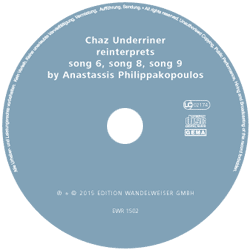EDITION WANDELWEISER RECORDS
> CD catalogue
>> chaz underriner
_____________________________________________________________________
<< >>
Chaz Underriner reinterprets Anastassis Philippakopoulos
| order reference: medium: composer: performer: |
EWR 1502 CD Anastassis Philippakopoulos Chaz Underriner, Armin Abdihodzic, Greg Dixon, Robert Trusko (electric guitars) |
 |
 |
>> Review Le Son du grisli (blog) >> Review Brian Olewnick (blog) Chaz Underriner reinterprets Anastassis Philippakopoulos 1 song 6 (2010) for flute Chaz Underriner (electric guitar, bass guitar) 2 song 8 (2012) for string orchestra Armin Abdihodzic (electric guitar), Chaz Underriner (electric guitar), Greg Dixon (electric guitar), Robert Trusko (bass guitar) 3 song 9 (2013) for bass clarinet Chaz Underriner (bass guitars) audio sample>> As I hear it, Anastassis Philippakopoulos' music moves from event to event. He writes melodies. They appear and sound fluid - but this is deceptive. Close experience with them, listening as Anastassis does repeatedly to the same succession, reveals that each tone arises from a decision. For Anastassis, a choice is an event - something to be weighed and evaluated. It is also a new beginning, a thing that puts other things in motion. This can make a simple sounding song into something like a landscape, with its own history of erosions and accidents, and a musical object that can never fully be grasped, only heard and heard again. Instrumentalists are challenged to find the song in a succession of events. Chaz Underriner's work with Philippakopoulos' music on this disc shares this insight. It is both an analysis of the melody events in three of the Song series and a new work in its own right. By exploding the duration of the pitches and putting distance between them (projecting the songs on a different scale altogether), very little of the "tune" remains audible. He makes a desert of a mountain range, rendering each tone with sensitivity to local detail, and turning melody into an experience we only have as a trace, and then only when it is completed. Michael Pisaro, May, 2014
|